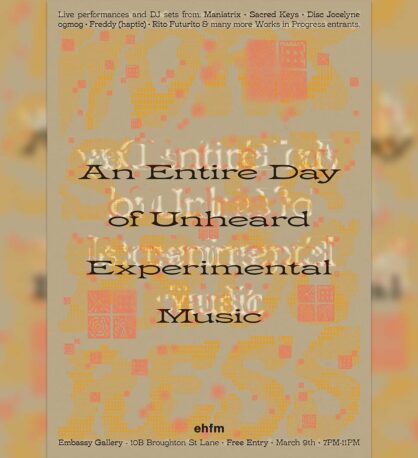Grandmother waits for you
Grandmother waits for you
Taking community to the next level
For this project the Embassy steps gingerly into the well-worn slippers of relational engineering. As collaborative practice continues to impose reparative solutions to the global disintegration of social space we invite members of the beleaguered multitude to witness a master class of alternative network management.
The central structure of the show feeds off the foundation of a bi-weekly knitting club. This ad-hoc, multi-generational congregation comprised a ‘master and apprentice’ formation exploring the future possibilities of a new neural thread technology. A plan was drawn up to create a yarn-based sculptural assemblage representing a sentient global network with individual granny squares, knitted toys and baby clothes acting as thriving nodal ‘hot clusters’ and random ends symbolising exclusionary ‘dread zones’.
Kicking into collaborative overdrive, the Embassy enlisted a small army of knitting groups, residents from sheltered accommodation and a ragbag of local artists to help in the construction of the knitsphere or interknit – a haptic interface communicating the utopian cyber-dream of disparate networks fusing electronically to form a shared consciousness. Otherwise known as the noosphere, this vast thinking membrane heralds an entirely new stage in human development. (http://en.wikipedia.org/wiki/Noosphere)
The highly volatile and psychically charged entity is buffered and cooled by an array of community panels displaying over 100 granograms from around the globe. These images are a response to a call for artworks relating to grandmotherhood. The wrinkly godheads of familial heritage, transport networks and ethereal sublimation hold the login codes to the great open-source empyrean. Follow the silver surfers!
Within each individual lurks a kernel of the truly divine. The time of Gnosis is upon us. Watch for the signs.
______________________________________________________________________________________
TEXT BY DR ANGELA MACLANAHAN
Grandmother Waits for You is a pseudo collaborative exhibition that employs metaphors of local and global ‘grassroots’-style community organisation in order to examine the nature and value of ‘networks’, social and otherwise, in the 21st Century. Taking cues from recent theories in the arts, social sciences and science studies, it brings together an ‘assemblage’ of materials, technologies and people to explore, and in some cases, to subvert, various kinds of connections between human beings and geographies, ‘cultures’, spaces and things, or between people and people, things and things, technologies and time, things and space, and so on.
A primary critical element of the exhibition lies in the manner in which it visually and materially uses ideas about ‘authenticity’ and ‘community’ to contest and subvert reactionary ideas about what globalisation is, and how it works. The primary feature of the exhibition is a large knitted installation entitled knitsphere, which fills the interior of the Roxy Art House Tower. This work is a ‘network’ of items that one might, on appearance, associate with recent sociocultural trends in Western society for participation in ‘knitting circles’, in which individuals, primarily women, engage both virtually and physically in groups that come together to produce craft and to participate in a kind of social interaction that actively produces and maintains social relations and thus, a kind of ‘community’, through consistent habitual practices involving frequent face to face and/or cyber meetings (Minahan and Cox 2007).
It has been argued that contemporary knitting circles could be evaluated as a reaction against globalization, while at the same time ironically employing the very technologies used to facilitate it. The subversion of globalization hence lies in the ways in which knitting circle aim to evoke ideas about ‘traditional’ methods of community interaction that those of us living in Western society might associate with the historical practices of women- specifically, in the context of this exhibition, the ‘grandmothers’ of those of us born in the latter half of the 20th Century onward- whose social interactions contributed to the existence of small, ‘close knit’ communities that flourished in a more ‘local’, and perhaps thus, more ‘humane’ world, which was as yet (in relation to neoliberal politics at least) ‘unglobalised’.
knitsphere critiques this appropriation of the ‘knitting circle’ and the naivity of ‘granny culture’ more generally by appearing on the one hand to have been produced by many people, but on the other, actually being the product of a very small number of individuals who worked on the piece in isolation from one another. The process used to make the exhibition thus plays with our assumptions about what we see, highlighting the oversimplification of the philosophical underpinnings of contemporary ‘knitting’ movements, highlighting instead the complex nature of human interaction- exposing the appropriation of ‘granny culture’ as conservative and perhaps, naïve analyses of the complex ways ‘communities’ work.
To extend the kinds of analyses presented here, one might go on to ‘trace’ how the exhibition relates to, and indeed produces, contradictory practices and meanings during its ‘lifetime’. In studying, for example, its production, installation, representation, the ways in which visitors engage with it, the people who had a hand in ‘curating’ it, and so on, one could learn a great deal about the Embassy itself, the way it engages with ‘cultures’ of contemporary art, the politics surrounding how such works are permitted to operate, and so on. The juxtaposition of the objects of the exhibition- and the relationships that these relations inevitably create – materialises and transforms different kinds of social interactions. Grandmother Waits For You grapples with the very kinds of issues addressed by anthropologist Marilyn Strathern (2004: xiv), who has said in relation to the highly networked world in which we currently live:
‘Perhaps it is… the concomitant ability to perceive more than one scale at the same time… that indeed makes the relations between phenomena appear as ‘complex’. Complexity is culturally indicated in the ordering or composition of elements that can also be apprehended from the perspective of other orders.’
-Angela McClanahan (Edinburgh College of Art)
Works Cited
Minahan, S. and Cox, J.W. (2007) Stitch’nBitch: Cyberfeminism, A Third Place and the New Materiality. Journal of Material Culture 12 (5).
Strathern, M. (2004) Partial Connections. California: AltaMira Press.
Community Project


